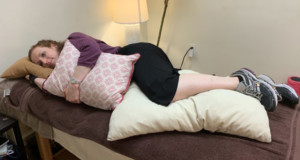Did you know that Americans currently get an average of 6.8 hours of sleep a night, and 20% of U.S. citizens have sleep disorders? The percentage of adults getting less than six hours of sleep per night has increased by 31% since 1985. These are staggering numbers considering that in 1910 the average person was sleeping nine hours a night. It should come as no surprise that sleep is important for mental clarity, muscle recovery, and metabolic regulation. One reason your sleep may be compromised could be your pillow. Pillows can affect your breathing, neck positions, as well as your spinal alignment.
So how do you choose the right pillow? Unfortunately, there is no one-size-fits-all answer. The correct pillow is based on your sleeping position, prior/current medical issues, as well as your mattress. These factors are all considered with the goal of optimizing your spinal alignment. A third of our lives are spent in bed, so sleeping in the correct position is essential, as sleeping in the wrong position can cause many injuries like muscle stiffness, tendonitis, nerve pain, herniated discs, and more.
What You Need to Know About Pillows
- Pillows don't last forever, and unless you are uncomfortable, you may not notice that you need a replacement:
- If you fold your pillow and it doesn't spring back, then it is time for a new one.
- Memory foam that no longer holds its shape should be replaced.
- Get to know your materials:
- Pillows made from down tend to be the fluffiest, but a combination of down with feather will be less expensive.
- Synthetic fill or down alternative are cheaper but still soft and supportive for those who are allergic to down.
- Memory foam is often thicker and firmer than other pillow materials.
- How you sleep matters in your pillow selection. Material can determine how supportive a pillow is, but its thickness makes a significant difference:
- Side sleepers need a thicker pillow.
- Stomach sleepers need a thinner pillow.
- Back sleepers fall somewhere in between for the recommended pillow thickness.
- Caring for your pillow:
- Whether your pillows are dry clean only or machine washable, you should wash them two to four times a year while also using a pillow protector.
- Test it out:
- I always tell my patients to buy a pillow from a place that has a return policy. Testing a pillow is essential, just as it is with mattresses.
- Your ideal pillow type may change over time:
- Health-related issues like weight and neck problems or changes with aging can result in new pillow type needs.
- It's all about the position of your neck in a neutral position omitting muscles be pulled or shortened. If your neck changes, so must your pillow.
Optimal Sleeping Positions with Pillows
Based on the position you sleep, a pillow can be used to optimize spinal alignment, so we must understand how to align our bodies best. Although these are recommended positions, we know that other factors may contribute to being optimal for everyone. If you have a softer mattress like a Tempur-Pedic, which is regulated by temperature, then your pillow height may be lower than if you had a firmer mattress to allow your neck to be in neutral. Below are some of the major sleeping positions and ideal pillow placements for each one:
Back Sleepers
 In this example, we have used pillows in the office to help support the legs and neck. The optimal position is to place one or more pillows under the knees to allow the spine to stay neutral and a pillow under the neck to keep the head straight with the chin being in an up or down position. Some people may require support under the curve of the neck if their curvature is more substantial. Avoid placing a pillow under your shoulders because this will bring them forward and cause rounding and discomfort for some. Additionally, if you have a shoulder issue, you may prefer a small pillow under your elbow to allow your shoulders to sit back in the sockets. Foam pillows offer more support to areas such as legs and hips, while the neck will vary based on your mattress and anatomy.
In this example, we have used pillows in the office to help support the legs and neck. The optimal position is to place one or more pillows under the knees to allow the spine to stay neutral and a pillow under the neck to keep the head straight with the chin being in an up or down position. Some people may require support under the curve of the neck if their curvature is more substantial. Avoid placing a pillow under your shoulders because this will bring them forward and cause rounding and discomfort for some. Additionally, if you have a shoulder issue, you may prefer a small pillow under your elbow to allow your shoulders to sit back in the sockets. Foam pillows offer more support to areas such as legs and hips, while the neck will vary based on your mattress and anatomy.
Side Sleepers
 Sleeping on your side can be a very challenging position for people with shoulder or back injuries due to the compression of the bottom shoulder, the rotation of the top shoulder, and the rotation of the lumbar spine. Although this photo example may seem like a lot of pillows, not all of them are necessary, and you can certainly modify the amount as needed. The key components here are aligning the spine in side-lying, but many side sleepers' top leg rolls forward or stretches the hip and back as they sleep. We found that placing a pillow (generally made of foam) in front of the bottom leg takes the pressure off the hip in terms of leg weight and stops hip rotation. The hip is still flexed, but the spine can be in alignment. The top arm often prefers hugging a pillow so that the trunk does not roll forward or back. The bottom arm is below 90 degrees, and the pillow is under the neck rather than the shoulder, supporting it to allow the cervical spine to be in neutral. Although this position might appear awkward, plenty of people find it to be quite comfortable.
Sleeping on your side can be a very challenging position for people with shoulder or back injuries due to the compression of the bottom shoulder, the rotation of the top shoulder, and the rotation of the lumbar spine. Although this photo example may seem like a lot of pillows, not all of them are necessary, and you can certainly modify the amount as needed. The key components here are aligning the spine in side-lying, but many side sleepers' top leg rolls forward or stretches the hip and back as they sleep. We found that placing a pillow (generally made of foam) in front of the bottom leg takes the pressure off the hip in terms of leg weight and stops hip rotation. The hip is still flexed, but the spine can be in alignment. The top arm often prefers hugging a pillow so that the trunk does not roll forward or back. The bottom arm is below 90 degrees, and the pillow is under the neck rather than the shoulder, supporting it to allow the cervical spine to be in neutral. Although this position might appear awkward, plenty of people find it to be quite comfortable.
Stomach Sleepers
 Sleeping on your stomach is historically not ideal, and the theory is that it puts too much stress on your thoracic and lumbar spine as well as stress on your neck. Often doctors will recommend sleeping on your back or side instead of sleeping on your stomach, especially if you have a back issue. One key to helping with this issue if you are unable to adjust your sleep position is to correct the position with pillows. You'll want a thinner pillow for your neck since it will be turned, and you want to make sure the pillow is not causing neck extension. You should also keep your arm below 90 degrees because placement above that angle can tighten the trapezius muscle, which pulls on both the neck and the shoulder.
Sleeping on your stomach is historically not ideal, and the theory is that it puts too much stress on your thoracic and lumbar spine as well as stress on your neck. Often doctors will recommend sleeping on your back or side instead of sleeping on your stomach, especially if you have a back issue. One key to helping with this issue if you are unable to adjust your sleep position is to correct the position with pillows. You'll want a thinner pillow for your neck since it will be turned, and you want to make sure the pillow is not causing neck extension. You should also keep your arm below 90 degrees because placement above that angle can tighten the trapezius muscle, which pulls on both the neck and the shoulder.
The lower body also needs to be aligned. One option is placing your leg to the side; although not ideal, it does decrease forces on the lumbar spine. Alternatively, a small pillow under the knee can minimize the weight of the leg when it is out to the side. Another option is to place a pillow under both feet, which will reduce pressure on the lower back. However, most people cannot stay in that position for a long time, so instead, it is recommended that they add a small pillow under their pelvis to help keep the lower back in neutral.
The above suggestions are basic guidelines and don't address individual issues or environmental factors. We understand that people move in their sleep, but starting in a position that has less muscle tension can help overall with sleep and pain.
Suggested Pillows
The pillows recommended below were highly rated from a variety of websites and have no connection to SetPT. We did test them in an independent event and found that people preferred the Wamsutta Medium Support Stomach Sleeper, whether they were a stomach sleeper or not. We recommend that if there is a hotel that you visit and love the pillows that you call and ask what they use; this is a great way of knowing your preference for pillows. Alternatively, you should check your store's return policy. Just like a mattress, you need to test pillows out to see their effectiveness.
- Side sleepers: Boll and Branch Down Pillow
- Back or side sleepers: Coop Memory Foam
- Stomach and side sleepers (flat pillow): Wamsutta Medium Support Stomach Sleeper Medium or Down Alternative Soft Pillow
- Back sleepers: Tempur-Pedic Neck Pillow
- Body pillow: Coop Home Goods Adjustable Pregnancy
For more information on sleeping and the proper sleeping positions, please contact your local SetPT office.





